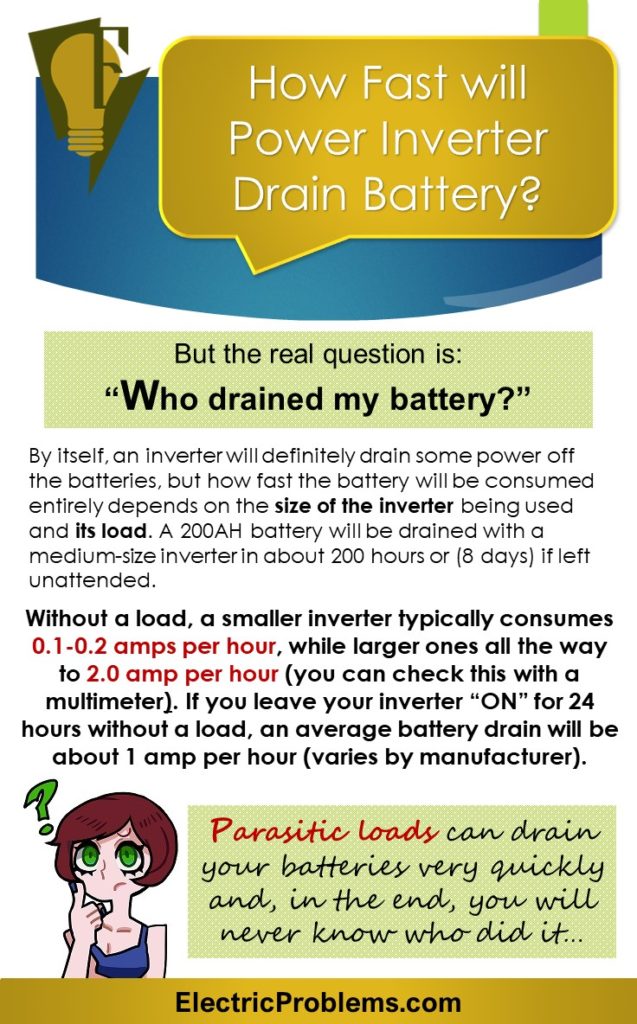![]()
How Fast will Power Inverter Drain Battery?
DISCLAIMER: AS AN AMAZON ASSOCIATE I EARN FROM QUALIFYING PURCHASES. THIS POST CONTAINS AFFILIATE LINKS THAT WILL REWARD ME MONETARILY OR OTHERWISE WHEN YOU USE THEM TO MAKE QUALIFYING PURCHASES. FOR MORE INFORMATION, PLEASE READ MY EARNINGS DISCLAIMER.
Without a load, a smaller inverter typically consumes 0.1-0.2 amps per hour, while larger ones all the way to 2.0 amp per hour (you can check this with a multimeter). If you leave your inverter “ON” for 24 hours without a load, an average battery drain will be about 1 amp per hour (varies by manufacturer).
But the real question is:
“Who drained my battery?”
 By itself, an inverter will definitely drain some power off the batteries, but how fast the battery will be consumed entirely depends on the size of the inverter being used and its load. A 200AH battery will be drained with a medium-size inverter in about 200 hours (or 8 days) if left unattended.
By itself, an inverter will definitely drain some power off the batteries, but how fast the battery will be consumed entirely depends on the size of the inverter being used and its load. A 200AH battery will be drained with a medium-size inverter in about 200 hours (or 8 days) if left unattended.
As it stops getting power from the battery, you will hear a loud beep and if you are reading this page, it is probably because you left your inverter working overnight and in the morning you no longer had your AC power. If your inverter did not have an auto disconnect option, you were probably also notified of this “wonderful” event in the middle of the night!
When the inverter starts beeping, this generally means that your battery is no longer supplying it with enough power to do its job properly! If you are just starting to shop for an inverter, it may be a good idea to get one that disconnects power when a low battery level is detected.
This way your battery will be protected from being drained too much, which in the long run will extend its lifespan. In reality, everything is probably fine with your inverter unless it’s really old and has a horrible efficiency ratio.
Your problem could be in the sizing of your inverter or your batteries. Also, there is one thing you should be aware of before blaming the inverter for discharging your battery:
There could be other things connected to the battery that may be you forgot about!
An inverter is a power device that will turn a DC current (batteries, solar) into an AC current that you can use for your AC appliances. They come in different sizes, from very tiny to industrial and their power is commonly measured in watts.
If you have a pre-built 12-volt battery system in your RV (for example), you will need to use a 12-volt inverter. If you are building a complete off-grid solar system, then 24- or the 48-volt inverter will be a better choice for you.
The Watt rating of the inverter is NOT what determines its power consumption and the battery will be drained according to the needs of your plugged-in equipment. So, how much current will the inverter and 300-watt load draw from your 200AH battery (for example)? Here is a breakdown:
Here is a nice video on different size inverters:
![]()
Here are three things to keep in mind when you are trying to determine the power usage of your inverter:
- Inverter efficiency level.
- Inverter size
- Load size
Now, let’s dig into the details!
1. Inverter efficiency
The efficiency level of an inverter is an indicator of how much power is being lost while converting DC current into AC (Alternating Current). Most quality power inverters in the market right now are very efficient with a power factor of around 1.1.
The efficiency formula goes as follows:
AC power output (watts) / DC power input (watts) = Inverter efficiency (%)
This means that if your inverter produces 900 watts of AC power from 1000 watts DC power coming in (for example), it has an efficiency of 90% or 1.11 “power factor”. Pure sine wave inverters are usually more efficient than modified sine wave inverters and high-frequency inverters are considered to be more efficient than low-frequency ones.
2. Inverter size
The second thing to consider is if your inverter is sized properly. Sizing an inverter is NOT complicated and all you need to do is to know what your load is:
All electronic and electrical equipment has some kind of label on the back with watt or amp information. In order to calculate your inverter size properly, you will need to add these numbers together and convert them into whatever power rating of your inverter is (either amps or watts) + give yourself a 20% headroom.
In case anybody is confused about why there are two power ratings on the inverter instead of one, this is because they are not the same and only one of them will be used to size your inverter:
- Continuous power. This is the power that will be supplied all the time (and your needed rating for calculation).
- Peak power. This is the power that will be supported during startup surges that last only for a short period of time (some equipment will state how much surge power they need).
3. Load size
Once you calculated your load size and figured out the efficiency of your inverter, now you can use the following formulas to figure out how fast the power inverter will drain your battery.
All you have to do is:
Divide amp hours (AH) of your battery by amps (your load) and you will get hours
If you are not sure how to get amps from watts, here is a formula for that:
Divide watts by volts to get amps
You may also want to add your efficiency ratio and inverter usage amps to these numbers (varies by manufacturer and model). The example below is for a 100 AH battery and is a simple calculation of battery runtime in hours (without efficiency and inverter itself).
Pay careful attention to how long your equipment will actually be used! We don’t use everything 1 hour at a time and might need only 10m, 30m, or 1h-and-a-half (for example).
The first thing you need to do in your calculation is to convert watts to amps. Then you divide AH (amp hours) by amps to get battery runtime (or hours):
|
AC load |
AMPs (watts/12v) |
100 AH |
|
50w |
4.16 |
24 h |
|
100w |
8.33 |
12 h |
|
200w |
16.66 |
6 h |
|
500w |
41.66 |
2.4 h |
|
1000w |
83.33 |
1.2 h |
|
1500w |
125.00 |
0.8 h |
|
2000w |
166.66 |
0.6 h |
** Very important! Even though these calculations are based on a specific formula, actual times may vary and depend on the battery condition. Also, don’t forget to cut down the final number in half in order to keep your battery at 50% discharge (unless it is a deep cycle one).
Feel free to save this infographic pin for future reference:
If you ever get sick and tired of all these calculations, you can always look into power monitoring devices (another article). When not in use, just turn that $#%@ thing OFF, and don’t worry about it!
You should also be aware of something called: “a parasitic load”, which is a tiny device that your battery is powering without you really knowing anything about it (like a smoke or propane detector). Parasitic loads can drain your batteries very quickly and, in the end, you will never know who did it…








